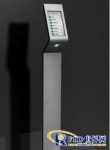
Application case of RFID access card label card in elevator management
[ad_1]
Elevators in the Capital Bank building in Raleigh, North Carolina, use passive 13.56 MHz tags and readers to optimize elevator traffic flow and reduce wait times for commuters.
Since September 2011, 300 employees working at the Capital Bank building in North Carolina have used RFID badges to ride elevators. The system, implemented by Raleigh Development Co. (RDC), allows employees working here to reach their destination floors without having to press an elevator key. Schindler Elevator provides the elevator dispatch terminal (PORT).

Elevator dispatch terminal (PORT)
Employees are handed a plastic ID card with an embedded RFID tag, scanned at one of five RFID terminals in the building, and assigned to the most efficient elevator. Don Carter, general manager of RDC, said: “The installation of the system has improved traffic flow within the 14-storey building, while also reducing staff wait times.
A few years ago, the old elevators in the building that had been in use for more than 40 years were long overdue for renewal. At that time, Carter decided to apply the latest technology to the elevators to reduce customer waiting time, improve elevator safety and passenger efficiency. At the same time save energy as much as possible. Using high-frequency radio frequency identification (13.56 MHz passive electronic tag in line with ISO 15693 standard) technology to upgrade the elevator technology, realize the identification of passengers, and automatically select the number of floors to be reached.
Although RDC researched several solutions, the company ultimately chose Schindler’s RFID-based elevator dispatch system because the solution provided by Schindler was more technologically advanced than the others, and with the development of Bluetooth technology, it is expected that Porting the technology to smartphones. Of course, this is just an idea and cannot be realized yet.
Schindler launched the elevator passenger dispatch terminal system in the United States in September 2009, with the purpose of improving the efficiency of passengers taking the elevator, and knowing the passenger’s destination floor before the elevator arrives.
The elevator dispatch terminal (PORT) consists of three parts: a computer, an RFID reader and a 7.4-inch touch screen. The Metropolitan Bank Building has installed five terminals: two at the base of the building’s main entrance, two at the elevator entrance and one between the car park and the building’s entrance. Schindler designs and provides hardware and Schindler ID software support for elevator scheduling and management of RFID-collected data.
When employees in the building use the RFID card to take the elevator, they first scan the RFID card at the elevator dispatch terminal, and select the floor to be reached according to the prompt information on the touch screen. The terminal will send the floor required by the passenger and the code of the smart card to the Schindler ID software through a wired connection, and the most appropriate elevator number (A, B, C or D) is obtained through the information processing of the traffic control mode in the software and displayed on the touch screen. .
Schindler ID software can not only calculate the best ride plan for passengers, but also store the historical data of personal use of elevators and automatically predict the destination of passengers based on the data. For example, if the user selects the 12th floor as the destination multiple times, the system will automatically assign an elevator to the passenger and display it on the terminal touch screen. If the user wants to go to another floor, the original information can be overwritten and the selection can be made again. If the number of floors a passenger reaches over a period of time is not fixed, several different floors will be displayed on the touchscreen. The user selects the “Auto Destination” option on the touch screen to obtain the above information.
The effect after the program is installed:
Four weeks after the system was implemented, thanks to the efficient management of the Schindler software, the elevators were less crowded. What’s more, the waiting time for passengers is greatly shortened. Passengers do not have to select the number of floors to reach by pressing a button, thereby reducing the risk of the spread of infectious diseases.
Direction of development:
Once Schindler has developed a smartphone app, users can select an elevator by tapping their phone once they enter the building. However, the system is likely to use a Bluetooth connection, rather than RFID technology. Over the next few months, Schindler plans to install the system in well-known buildings including Hyatt New Orleans and the twin towers of the World Trade Center in New York.
[ad_2]



